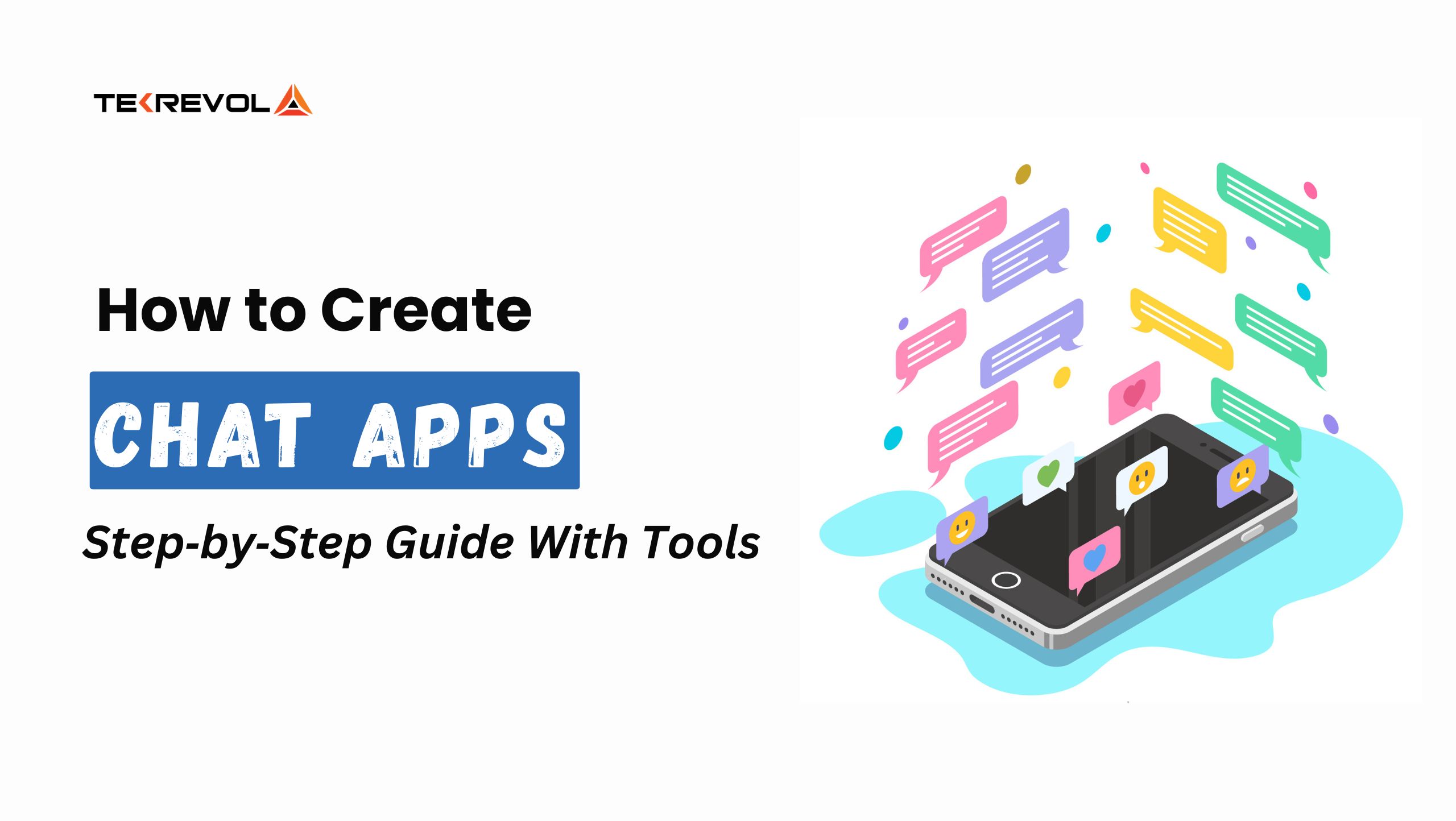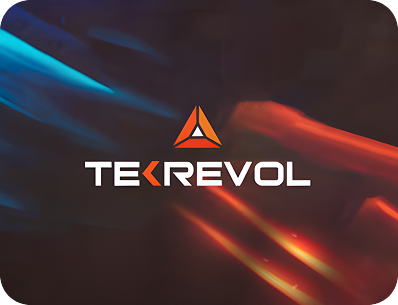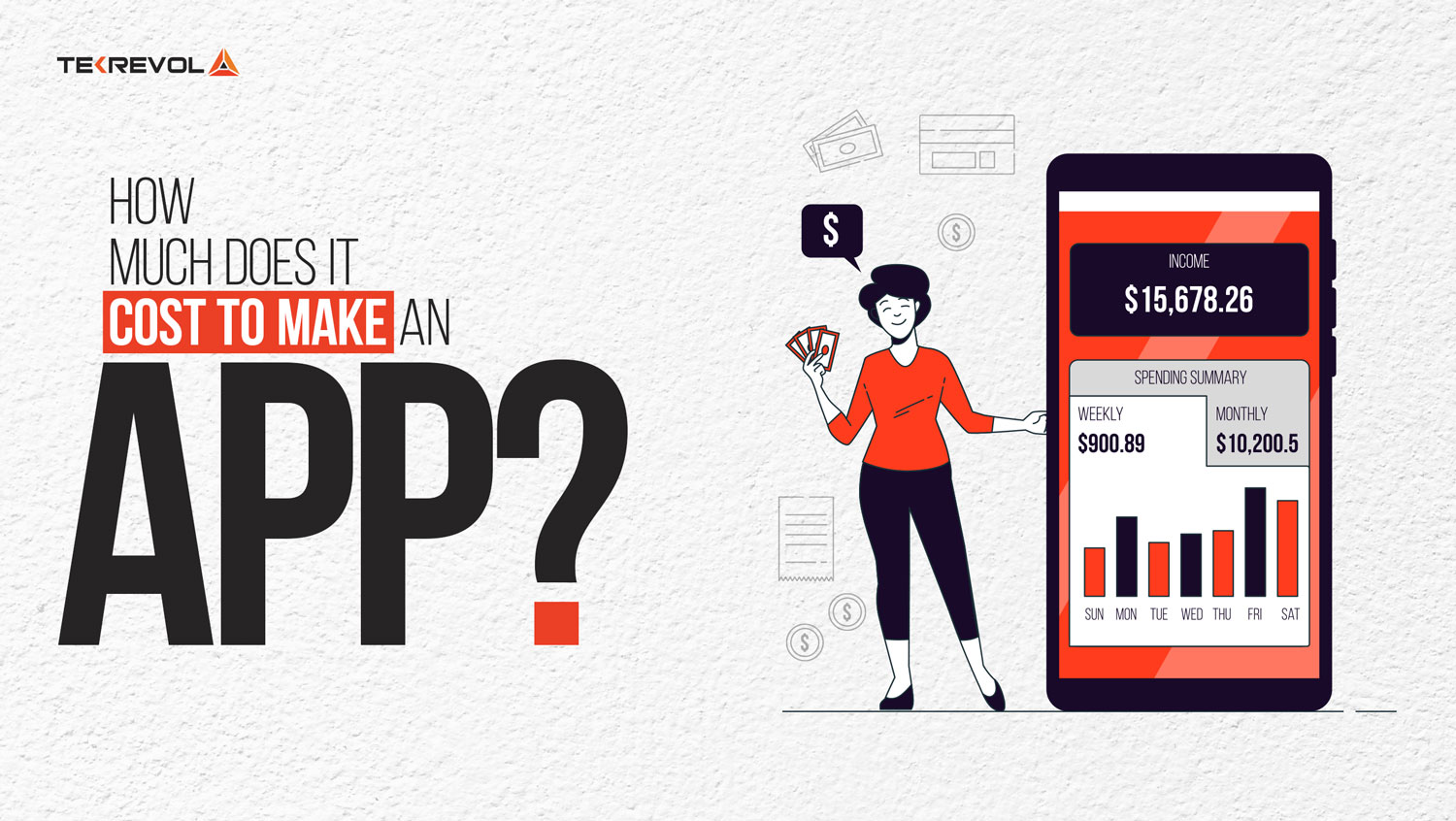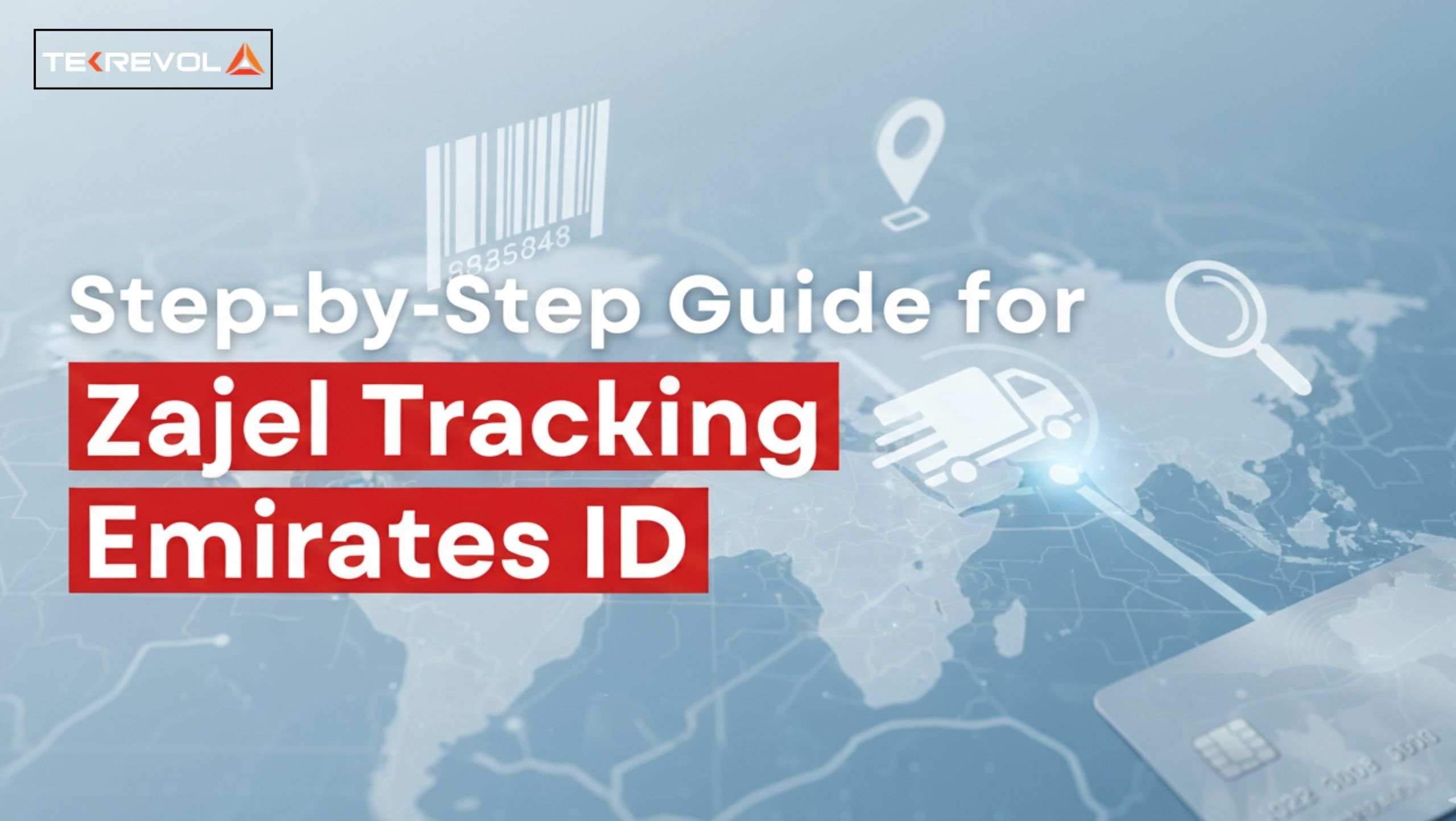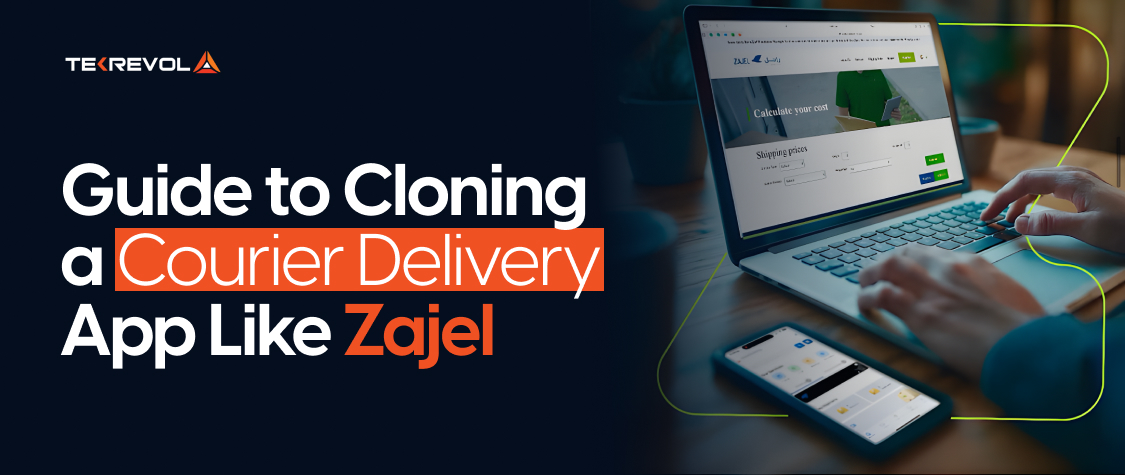From sending handwritten letters to chatting via real-time instant messaging, communication has come a long way in a short span. Today, over 3 billion people use chat apps each month for business, support, socializing, and everything in between. (Source: Investopedia)
However, explosive growth means intense competition to create a chat app that truly stands out. That’s why you need a roadmap with a scalable tech stack and predefined features beyond chat bubbles and push notifications to develop an app that people not only use but love.
In this guide, we’ll show you how to create a chat app free without coding, or with full-stack customization. Whether a tech founder or just exploring an idea, you’ll find everything from features and timelines to costs and challenges here.
What is a Chat App?
A chat app is a software application that people can send messages, images, videos, and files anywhere in the world in real-time. It works across devices using an internet connection to support group chats, voice notes, besides text. Top chat and video calling apps, like WhatsApp, Messenger, and Slack, bridge the global communication gap.
Why Create a Chat App in 2025?
Real-time messaging has become a global communication style now. No matter; it’s teams asking for feedback, couples planning dates, or niche communities sharing real-time news, people want fast, reliable chat. Here’s why the timing to create chat online apps or services in 2025 couldn’t be better.
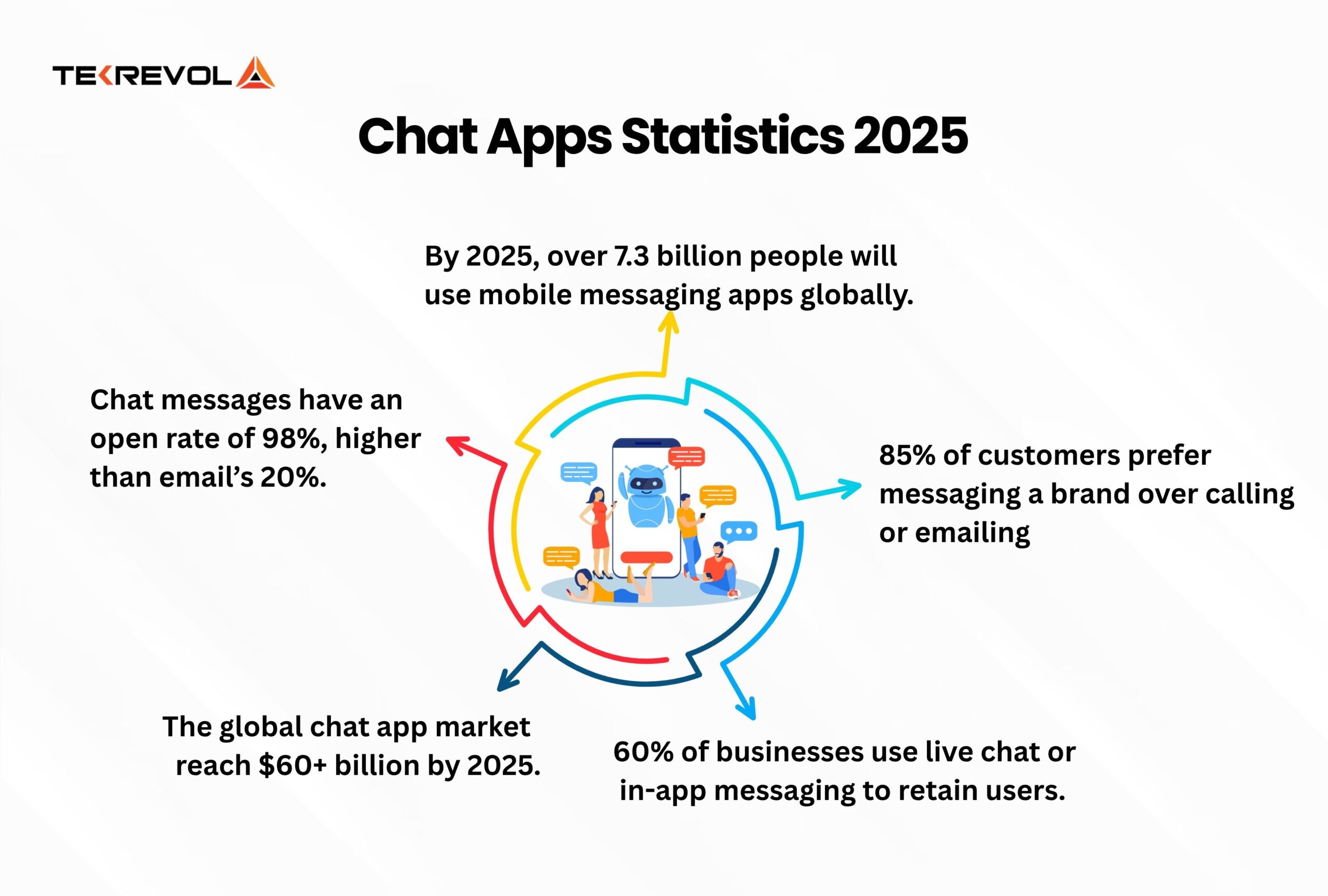
Growing Market
According to Statista, the number of global chat app users is expected to hit 3.6 billion by the end of 2025, and the number continues to rise. It represents nearly half the planet using messaging apps every month, promising an excellent opportunity to create a chat app.
Rising Users Expectations
While chatting, 82% of people expect a response in under 10 minutes, according to Salesforce. That’s a huge opportunity. Creating chat apps with real-time messaging, push alerts, and automation can seriously improve user retention.
Untouched Niche Market
While WhatsApp and Messenger dominate the industry, the space isn’t completely full yet. There’s a dearth of customized chat apps that serve specific audiences; let’s say private groups, fan communities, healthcare teams, or fintech users needing secure messaging.
Monetization Flexibility
Chat apps today aren’t just for communication; they’re revenue engines. Subscriptions, premium upgrades, paid groups, and branded experiences can even make a niche chat app profitable.
Tech Impact
Advancements in AI, video quality, and security protocols make it effortless to create a chat app that is sleek and user-centric with unique features that scale to meet potential needs.
Need Advice to Create a Chat App?
Talk to Tekrevol’s strategists and get market-fit insights before you start..
Schedule a Free ConsultationWhat Are the Most Popular Chat App Examples?
Messenger from Meta is the most popular chat app in the USA, with over 140 million users. WhatsApp is the global giant with over 2 billion users. Meanwhile, Google Messages just crossed 1 billion users, driven by RCS upgrades.
| Chat App | Global Users | Key Features | Best Known For |
| 2.78 billion | peer-to-peer encryption, global reach, media sharing | Secure international messaging | |
| Facebook Messenger | 1.04 billion | Text, voice calls, bots, group chats | Social messaging |
| Google Messages | 1 billion | RCS + SMS, high-quality media sharing | Native Android texting |
| Telegram | 900 million | Cloud sync, channels, secret chats | Broadcast messaging, privacy tools |
| Snapchat | 800 million | Disappearing chats, multimedia features | Gen Z conversations |
| Discord | 560 million | Voice, video, community channels | Gamers and communities |
| Signal | 40 million | Encrypted chats, no data tracking | Privacy-first chat |
Core Features To Create a Chat App
No chat app is complete without real-time messaging, message history, and secure communication. It should also support push notifications and media sharing. Every modern chat and messaging app also has scalability and cross-platform sync, which makes users stick to it.
Basic Features Every Chat App Needs
- Real-Time Messaging: Users expect fast, lag-free delivery. Over 23 billion text messages are sent every minute worldwide (Source: Forbes), and apps like Messenger and Telegram handle these massive volumes with sub-second latency.
- Message History & Sync allows people to pick up conversations across devices, even if they switch phones.
- Push notifications help bring users back in. Without them, your chat app fades into the background.
- Media & File Sharing: Photos, videos, and docs are now basic expectations. WhatsApp supports sharing files up to 2GB for mobile users.
Advanced Features to Create a Modern Chat App
- End-to-End Encryption (E2EE): Since privacy is now a selling point, full encryption is mandatory to protect user data from leaks or snooping.
- Typing Indicators & Read Receipts boost transparency as users can see if their message was seen or when someone is typing, which also makes chat feel real-time.
- Group Chat & Broadcast Messaging are essential for communities and teams to control group and broadcast tools.
- Multi-Device Compatibility & Scalability: The app must support iOS, Android, and the web. A cross-platform app development company assists in creating an app to deliver this, scaling up to millions of users without choking.
How to Create Chat App Online?
There are three practical ways to create chat app online:
- Using no-code platforms
- Custom Development from scratch
- Integration of third-party chat SDKs or APIs
Each method has its plus and minuses, irrespective of how well the process is carried out, and serves entirely different use cases.
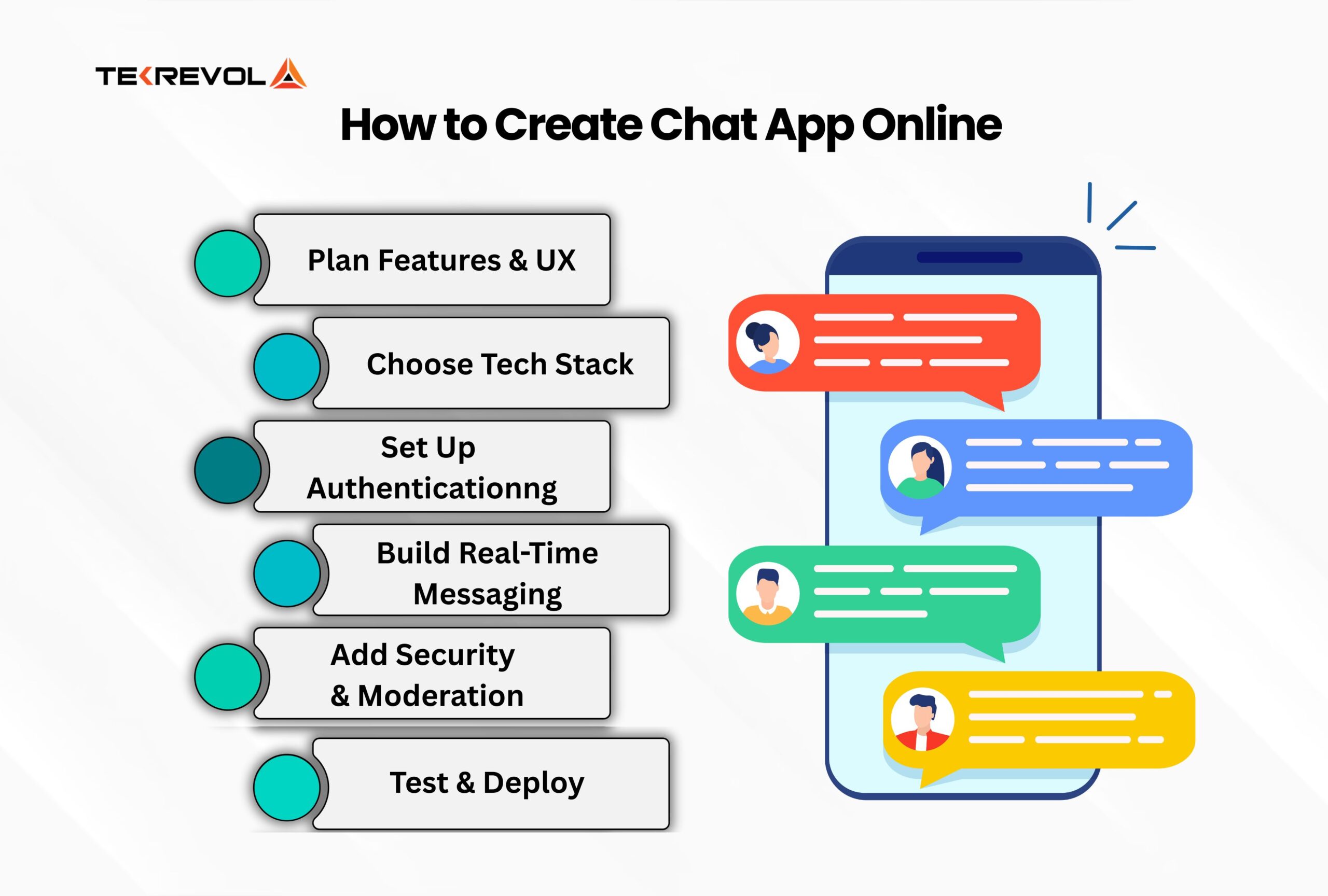
Preliminary Steps
Instead of blindly selecting a method to build a chat app, you must work on the foundation first. So, take a moment to observe these few basic steps to create a chat app that will save you time, money, and technical debt later.
- Define your chat app objective
- Identify Your Audience
- Clarify Use Requirements
1st Method: How to Create a Chatting App for Free Using No-Code / Low-Code Platforms
This method is best for MVPs, non-developers, and quick launches. 45% of early-stage startups in 2024 used no-code tools to validate product ideas (Source: SideTools). Here are the steps to create chat app free without coding:
- Choose a no-code tools that support messaging features. Your options are Adalo, Glide, or Thunkable.
- Add a chat module from a pre-built chat component or select a messaging template. Drag it into your app interface.
- Set up messaging architecture using built-in tools or integrate with Firebase Auth so users can securely sign in and send messages.
- Link the module to a database to store chat messages, user data, and media files.
- Work on the app UI, i.e, colors, fonts, and layouts. Then, test the chat flow to spot any bugs or data sync issues.
- Launch the app on iOS, Android, or as a PWA directly from the no-code builder.
Pros:
- No coding required
- Fastest launch time (within hours)
Cons:
- Limited design freedom
- Scalability and feature depth are restricted
2nd Method: Custom Code From Scratch
You can use a custom code approach when you need full control, scalability, and to offer unique features. According to Clutch, over 70% of enterprise-focused chat apps use custom-developed solutions for internal security and data handling needs.
Here are the detailed steps explaining how to build a chat app like WhatsApp with custom code:
- Design the chat interface with React or Flutter frameworks. Don’t forget to include components like message bubbles, input fields, and contact lists.
- Implement real-time messaging using WebSockets with Socket.IO. You can also integrate Firebase Realtime Database for real-time message exchange between users
- Build the backend server using Node.js, Python (Django), or Java (Spring Boot). Be sure to include key features like
- User registration and message storage
- Push notification and Media upload support
4. Pick a database (MongoDB, PostgreSQL, or MySQL) to store user profiles, chat logs, and media files.
5. Once you’ve got the core features in place, test messaging, logins, notifications, and especially security.
6. Live your app using platforms like AWS, Heroku, or Render, and set up CI/CD pipelines so you can roll out updates without any downtime.
Pros:
- Complete control and scalability
- Can be modified to your brand and UX
Cons:
- Time-consuming and expensive
- Requires experienced developers
3rd Method: Use Ready-Made Chat SDKs or APIs
This method is recommended for apps with fast time-to-market and production-grade messaging features:
- Select any reliable messaging service like Sendbird, MirrorFly, CometChat, or GetStream. Your choice is based on pricing, scalability, and features.
- Set up your account to create a new project. You’ll find your API keys on the provider’s dashboard.
- Install the SDK into your mobile or web app. Most providers support React Native, iOS, Android, and web frameworks.
- Configure the chat system with your existing user authentication method to link messages to specific users.
- Customize UI with the help of the provided kit or build your interface using the SDK’s methods and callbacks.
- Monitor your app uptime, chat volume, and user engagement through built-in dashboards and regularly update the SDK for security.
Pros:
- Saves months of backend work
- Enterprise-grade performance
Cons:
- Ongoing costs
- Locked into vendor updates and pricing
Not Sure Which Chat App Method Works Best?
Tekrevol compares and picks the best approach tailored to your budget and scalability goals.
Book a Strategy Session NowHow Much It Costs to Build a Chat App?
Chat app development cost can go $25,000 to $250,000 or above, depending on the features, tech stack, and development team.
A simple app like a customer support live chat might only need messaging and authentication may cost around $25K–50K. But a full-scale app like Slack, Discord, or WhatsApp needs group chat, file sharing, voice/video, encryption, and moderation can go up to $250K.
According to GoodFirms, over 38% of app budgets go into implementing voice/video features and data encryption. Another 26% of the cost is usually spent on scalable backend and chat infrastructure.
| Feature / Module | Estimated Hours | Cost (Avg/hr) |
| Authentication | 60–80 hrs | $3,000–$4,000 |
| Chat engine (1:1 messaging) | 80–100 hrs | $4,000–$5,000 |
| Group chat | 100–120 hrs | $5,000–$6,000 |
| File transfer (media) | 80–100 hrs | $4,000–$5,000 |
| Voice and Video calls | 200–250 hrs | $10,000–$12,500 |
| End-to-end Encryption | 150–200 hrs | $7,500–$10,000 |
When budgeting, also include backend costs, ongoing maintenance, and future updates. Building an MVP first is a smart way to validate before spending six figures on full development.
Important Technology Stack to Create Chat Applications
Not just chat but every real-time app runs on three key pillars: a backend, a frontend, and security. The backend tools, namely Node.js and WebSockets, handle live message flow. On the frontend, Flutter or React Native makes the interface user-centric. Whereas encryption and authentication (like JWT) keep things private and secure. Together, they make sure messages are fast, synced, and safe.
1. Backend Technologies
The backend handles real-time connections. Node.js, Elixir, and Python do the best job on the language part. Whereas, WebSockets or Socket.IO keep the line open between the user and the server, so messages show up instantly, not five seconds later.
2. Frontend Frameworks
Frontend focuses on the user part of the app, like responsiveness, visuals, layout, and ease of use. The best Cross-Platform tools, like React Native or Flutter for the app, aim to support both OS – Android and iOS. However, if maximum performance is your goal, Swift (iOS) and Kotlin (Android) ensure a balance between speed and flexibility.
3. Messaging Architecture
Messaging architecture defines how a message travels from sender to receiver through a system in real time. To create a smooth flow, use WebSockets since it is fast and consumes less data than older methods like refreshing every few seconds.
4. Security Layers
Security is critical when you create chat applications. JWT tokens secure logins and encryption protocols, ensuring chats stay private, no matter what.
How Long Does It Take to Build a Chat App?
Usually, 2 months are enough to create basic chat apps. However, feature-packed apps like WhatsApp or Slack can take a year or more. The timeframe for developing an app depends on complexity, team size, and tech stack.
| App Type | Estimated Time | Development Hours (Approx.) |
| Simple MVP | 2–4 months | 133–400 hours |
| Medium Complexity | 4–7 months | 400–800+ hours |
| Feature-Rich App | 7–12 months | 800–1600 hours |
What Are Common Challenges of Chat App Development?
Building a chat app seems piece of cake until you deal with a growing user base, lagging messages, or spam floods into your system. Here are the main issues you may face with practical tips to handle them.
Latency and Performance at Scale
As more people use the app same time, it loads the system, which results in latency. To avoid lagging, timely scale your backend with tools like WebSockets, Redis, and horizontal autoscaling. You can also use caching to reduce message delivery lag.
Feature Overload Before Launch
Packing in too many features delays app launch. Initially, launch an MVP with essentials such as login, chat, and notifications, then add advanced features after feedback or when scaling.
Spam, Trolls, and Moderation Woes
Trolls, spam, and abuse can cause a negative user experience. Apply AI filters, keyword detection, and a basic human review system to flag such inappropriate content early.
Meeting Privacy Regulations
Healthcare and financial apps deal with sensitive information; therefore, compliance with HIPAA or GDPR is required. Aside from regulatory compliance, use end-to-end encryption, secure APIs, and store only the necessary info with permission to avoid lawsuits.
Why Choose Tekrevol for Chat App Development
Chat app isn’t just all about sending or receiving messages. Their successful development means achieving the balance between speed, security, scalability, and design. From instant message delivery to real-time sync and encryption, every part of the system needs to coordinate smoothly.
Without the right expertise, things can quickly be delayed, bugs and compliance gaps. Tekrevol mobile app development services map out the right tech stack, frameworks, and cloud services to fit your use case and budget.
Our experience with cross-platform tools allows faster rollouts, while native builds offer peak performance. We’ve helped startups and enterprises across fintech, education, and e-commerce create a messaging app like WhatsApp for free that scales and sticks.
Ready to Create Your Custom Chat App?
From MVPs to enterprise-grade messaging platforms, we deliver secure, scalable results.
Talk to Our App Experts Today
